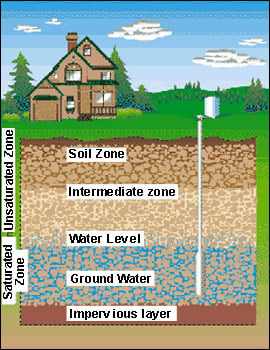

The movement of ground water occurs both vertically and horizontally in response to gravity and hydraulic pressure. This movement is through the aquifers which are the well-saturated zones. These zones consist of a layer of rock or sediment that is permeable to ground water flow in usable amounts. The main method of ground water movement is through percolation. This movement is much slower than that of surface water and is dependent upon the amount of slope in the water table.
The two most common means to obtain supplies of ground water are springs and wells. A spring is the simplest source of ground water as it occurs naturally. Springs occur in areas where there is a significant change of permeability in the horizontal direction.
The change in permeability must occur with the upper sedimentary material more porous than the lower material. Thus, flow is greater through the more porous matter and as the flow reaches the less porous matter, a spring emerges. Although, once this water emerges, it is considered surface water.
Excavating a well to obtain ground water is a much more complicated process. In order for planners and developers to determine the location of a well, they must find a reliable source of ground water. In general, sedimentary rocks have the greatest porosity. Such rock types include sandstone and limestone. These define excellent aquifers.
This issue of under-ground water storage is very important when considering a well. Water is stored in the voids of rock and soil. In order to determine which areas are in a favorable condition for drilling, one must consider many different factors. Precipitation or the source of infiltrated water is probably the most important. There must be a sufficient amount of water to fill the available pore spaces. The zone where the water is to infiltrate must have a high porosity in order to contain an adequate amount of water. Plus, the area in which the water is to be stored needs sufficient permeability to allow water to flow into the well and replace the water that is pumped out of the well.
Ground water may pick up minerals and metals as it passes through the aquifer, or may become contaminated by surface water run-off from agricultural, industrial or residential development.






